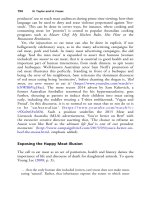The palgrave international handbook of a 333
Bạn đang xem bản rút gọn của tài liệu. Xem và tải ngay bản đầy đủ của tài liệu tại đây (39.81 KB, 1 trang )
Fish used in Aquariums: Nemo’s Plight
331
Audubon (2015). Audubon nature institute. />rium/explore-aquarium/aquarium-exhibits/386-gulf-of-mexico-exhibit. Accessed
18 November 2015.
Barnett, C. W., & Pankhurst, N. W. (1998). The effects of common laboratory and
husbandry practices on the stress response of greenback flounder (Rhombosolea
tapirinia, Gunther 1862). Aquaculture, 162, 113–329.
Beirne, P. (1999) For a nonspeciesist criminology: animal abuse as an object of
study. Criminology, 37(1), 117–147.
Beirne, P. (2007). Animal rights, animal abuse and green criminology. In P. Beirnes
& N. South (Eds.), Issues in green criminology: confronting harms against environments, humanity and other animals. London: Routledge.
Beirne, P. (2014). Theriocide: naming animal killing. International Journal for
Crime, Justice and Social Democracy, 3(2), 50–67.
Bekoff, M. (2007). Aquatic animals, cognitive ethology, and ethics: questions about
sentience and other troubling issues that lurk in turbid waters. Diseases of Aquatic
Organisms, 75(2), 87–98.
Bentham, J. (2005). Introduction to the principles of morals and legislation. Oxford:
Oxford University Press. (First published, 1789).
Benton, T. (1998). Rights and justice on a shared planet: more rights or new
relations? Theoretical Criminology, 2(2), 149–175.
Bradshaw, L. (2014). State-corporate environmental cover-up: the response to the
2010 Gulf of Mexico oil spill. State Crime Journal, 3(2), 163–181.
Braithwaite, V. (2010). Do fish feel pain? Oxford: Oxford University Press.
Braithwaite, V., & Huntingford, F. (2004). Fish and welfare: do fish have the
capacity for pain perception and suffering? Animal Welfare, 13, s87–s92.
Briefing prepared by TRAFFIC for the European Commission TRAFFIC. 2015.
/>%202014.pdf
Brisman, A. (2012). The cultural silence of climate change contrarianism. In R.
White (Ed.), Climate change from a criminological perspective (pp. p. 41–70). New
York: Springer.
Brisman, A. (2014). Environmental and human rights. In G. Bruinsma & D.
Weisburd (Eds.), Encyclopedia of criminology and criminal justice (Vol. 3,
pp. 1344–1345). New York: Springer Verlag.
Brisman, A., McClanahan, & B., South, N. (2014). Toward a green-cultural
criminology of ‘the Rural’. Critical Criminology, 22, 479–494.
Brisman, A., & South, N. (2012). A green-cultural criminology: an exploratory
outline. Crime Media Culture, 9(2), 115–135.
Brisman, A., & South, N. (2014). Green cultural criminology: construction of environmental harm, consumerism, and resistance to ecocide. London: Routledge.
Brown, C. (2014). Fish intelligence, sentience and ethics. Animal Cognition, 18(1),
1–17.
Buber, M. (1970). I and Thou (trans. W. Kaufman). New York: Touchstone.









